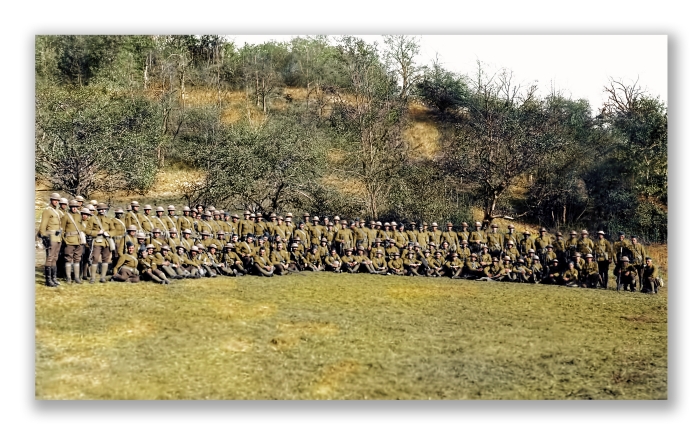In the early Summer of 1918 my grandfather, Pvt. Frank G.S. Erickson was
transferred from the 160th Infantry (40th Division) to the 308th Infantry. Frank
and his Company H were now part of the 77th Division. Within four months
the men would be part of one of the most historic moments in the war. A seven
day intense experince that would change every man forever.
Frank, Grandmother Clara and my father Ernest Anders kept many of the things
that passed through their lives that meant something significant. Keepsakes,
letters, postcards, countless photographs and odd little things, that in time
became even more important. I can relate to their actions quite well. I have carried
on their flame. Frank's archives from his cowboy days, his time in the service
and beyond held significant importance to me my whole life and continues to as
I work on the Family Archive Project.
Most momentous of all this is the fact Frank was a surviving member of the
'Lost Battalion.' That name was given to the nine companies of the 77th Division,
consisting of five hundred and fifty four men that were isolated by German forces
from October 2nd through the 8th, 1918 during the Meuse Argonne Offensive in
France.
One hundred and ninety seven men were killed in action and approximately one
hundred and fifty went missing or were taken prisoner before the remaining men
escaped. They emerged through 'The Pocket' of the Argonne to return to their lines.
Frank recalled to me being obviously quite relieved, yet overwhelmed at what he
had experienced. Having been mustered gassed and witnessing so many of his
comrades perish was life changing.
Frank received this bullet from his commanding officer, Captain William J. Cullen.
It was a gift, a token of respect for his actions as Cullen's runner during that early
October 1918 period in the Argonne Forest. He also received a beautifully written
note (postcard) of appreciation that is attached below.
Frank joined the American Expeditionary Force in 1917 and entered training at Camp
Lewis near Tacoma, Washington and then moved onto Camp Upton in Long Island, NY.
He was a rifleman and a runner with Company H.
Led by Major Charles White Whittlesey on the 2nd of October, the division quickly
advanced into the Argonne, under the belief that French forces were supporting the
left flank and two American units including the 92nd Division were supporting the
right flank.
Unknown to Whittlesey's unit, the French advance had been stalled. Not aware of this
the Americans had moved beyond the rest of the Allied line and found themselves
completely cut off and surrounded by German forces. For the next seven days, suffering
heavy losses, the men of the division were forced to fight off numerous attacks by the
Germans.
The battalion suffered many hardships. Food was scarce and water was available only
by crawling, under fire, to a nearby stream. Ammunition ran low. Communications were
also a problem, and at times they would be bombarded by shells from their own artillery.
Frank and the other runners of the command were dispatched by Whittlesey for various
reasons, many became lost or ran into German patrols. Many succeeded as Frank did to
carry the messages where ordered. As time went by quickly carrier pigeons became the
only method of communicating with headquarters. In an infamous incident on the 4th of
October, inaccurate coordinates were delivered by one of the pigeons and the unit was
subjected to 'friendly fire' bombardment.
The unit was saved by another pigeon, Cher Ami, delivering the following message:
"WE ARE ALONG THE ROAD PARALLEL AT 276.4. OUR ARTILLERY IS DROPPING A
BARRAGE DIRECTLY ON US. FOR HEAVENS SAKE STOP IT."
Despite this, they held their ground and caused enough of a distraction for other Allied
units to break through the German lines, which forced the Germans to retreat.
The bullet was given to my father, Lt. Ernest Anders Erickson by Frank when he shipped
off to England in late 1943. He was serving in the Air Corps as a pilot of a B-17. Flying out
of Horham Airfield he completed thirty five missions over Nazi occupied Europe in 1944.
Ernest carried the bullet throughout the war and brought it home in 1945 and returned it
to Frank. It had proved to be a good-luck charm. Over the years whenever I visited Bismarck,
Frank would show me the bullet and tell me the stories connected with it. My father inherited
Frank's archives including the bullet in 1995.
The illusion in the photograph that there are two bullets is a bit of artistic license. I needed
to be able to show the full inscription which wraps around the barrel of the bullet.
It states: Fired By Frank Erickson of Lost Battalion France 1918.



